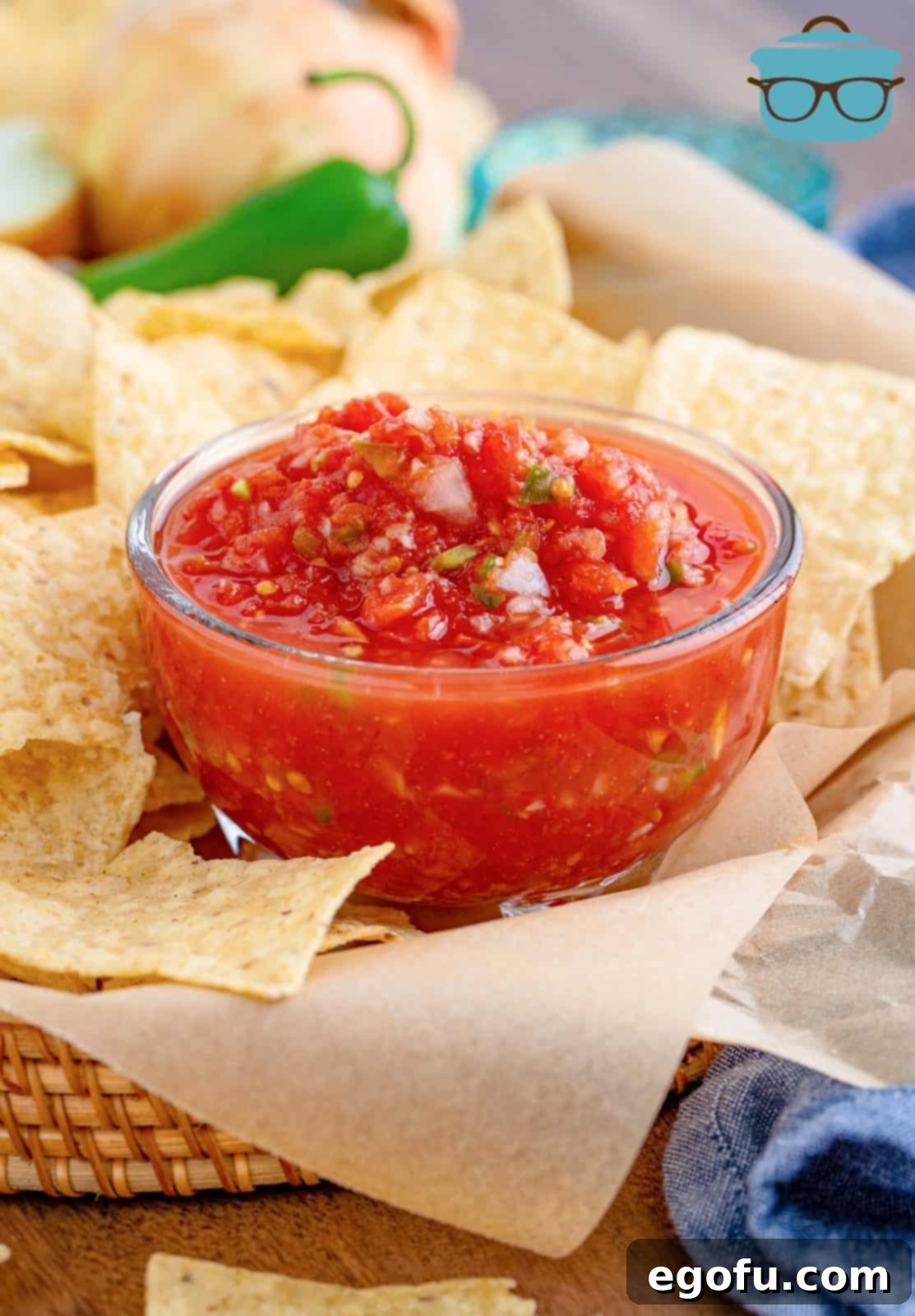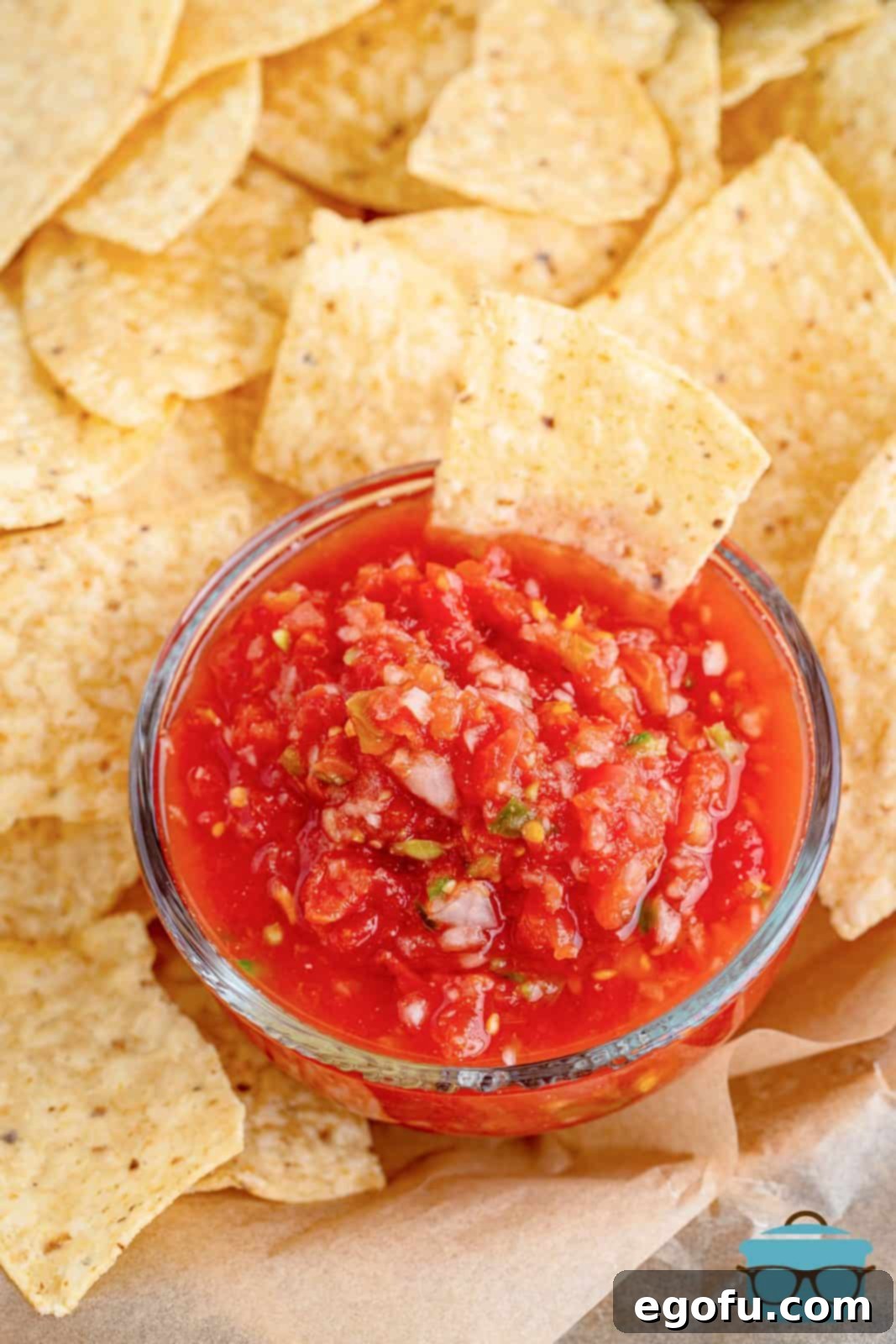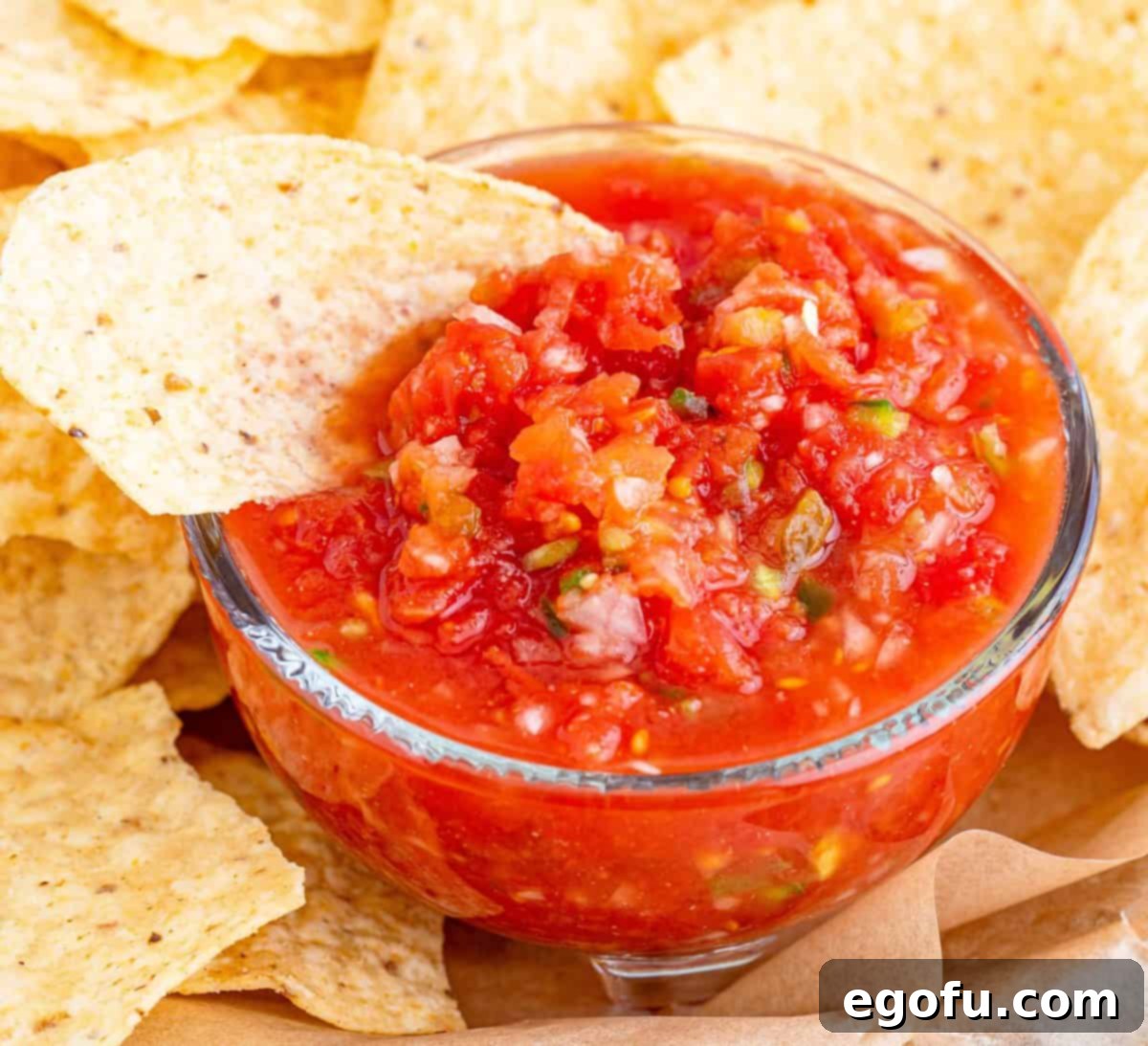This incredible copycat Chili’s Salsa recipe is remarkably simple, allowing you to whip up a batch of authentic, restaurant-quality salsa in just five minutes. Featuring fresh, vibrant tomatoes, crisp onions, a perfectly balanced blend of seasonings, and a hint of fiery jalapeño, this recipe brings the beloved taste of your favorite Tex-Mex appetizer right to your kitchen table. Prepare to delight your taste buds with a homemade salsa that’s not just easy, but truly extraordinary.
Unlock the Secret to Chili’s Famous Salsa at Home
Few things compare to the joy of dipping a warm, crispy tortilla chip into a perfectly seasoned bowl of salsa. Chili’s has long been synonymous with serving up one of America’s most cherished restaurant salsas – a dip that strikes a beautiful balance between smooth texture, fresh flavor, and just the right amount of kick. Now, imagine recreating that exact experience, or even elevating it, from the comfort of your own home. This copycat Chili’s Salsa recipe does exactly that.
What makes this salsa truly stand out? It’s not just the speed with which it comes together, but its delightful consistency and flavor profile. Unlike some salsas that can overwhelm with excessive chunks or an acidic bite, our homemade version boasts a silky smoothness that perfectly complements any dish without overpowering it. The flavors are bright and fresh, with the tang of tomatoes harmonizing beautifully with the subtle sweetness of onion and the aromatic depth of cumin. The jalapeño adds a customizable touch of heat, ensuring every bite is as exciting as the last.
Many who try this recipe claim it tastes as good as, if not better than, what you’d get at Chili’s. The secret lies in fresh ingredients and a surprisingly simple blending process that allows all the flavors to meld into a harmonious symphony. Whether you’re hosting a party, enjoying a casual meal, or simply craving that signature restaurant appetizer, this easy-to-make salsa will quickly become your go-to recipe.

Frequently Asked Questions About Homemade Salsa
For fresh salsa like this Chili’s copycat recipe, cooking is generally not necessary, and often not desired. The appeal of a fresh salsa is its vibrant, uncooked flavors. However, if you’re using whole fresh tomatoes with skins, you might consider a brief blanching process to easily remove the skins. This involves briefly boiling the tomatoes, then plunging them into ice water, which makes the skins peel off effortlessly. If you desire a smoother consistency from fresh tomatoes, gently cooking them until they soften before blending can help achieve that texture, but canned tomatoes (like those in this recipe) already provide the desired softness and flavor without extra cooking steps, making the process much quicker and simpler. Cooked salsas, often referred to as “salsa roja” or roasted salsas, have a deeper, smokier flavor profile, which is different from the bright, fresh taste we’re aiming for here.
Vinegar, or other acidic ingredients like lime juice, are primarily added to salsa for preservation purposes, especially when canning or jarring it. The acidity helps lower the pH level of the salsa, creating an environment that inhibits the growth of dangerous bacteria, particularly botulism. For commercially jarred salsas, this is a standard food safety measure to ensure shelf stability. For fresh salsa that you intend to eat within a week and store in the refrigerator, adding extra acid like vinegar is generally not required for safety, as long as proper hygiene practices are followed during preparation. However, a touch of lime juice or vinegar can also enhance the flavor, adding a bright tang that complements the tomatoes and spices, so some recipes include it for taste, even in fresh batches.
At its heart, traditional salsa, particularly “salsa fresca” or “pico de gallo,” is a simple yet incredibly flavorful condiment. The foundational ingredients typically include fresh tomatoes, white onion, chili peppers (such as serrano or jalapeño), and a blend of spices, with cilantro being a very common addition. These ingredients are often finely diced and mixed together, allowing their natural flavors to shine. The preparation method can vary by region and personal preference; some traditional salsas are made using a molcajete (a Mexican mortar and pestle) for a rustic texture, while others might involve roasting the vegetables before blending for a deeper, more complex flavor. This recipe for Chili’s copycat salsa maintains that traditional base of tomatoes, onions, and chilies, enhanced by specific seasonings to replicate that classic restaurant taste.
If you enjoy your salsa with a significant kick, there are several effective ways to increase the heat. The primary source of spiciness in chili peppers like jalapeños comes from capsaicin, which is most concentrated in the seeds and the white membranes (or pith/veins) inside the pepper. To make your salsa spicier, simply include more jalapeño, and make sure to leave in a good portion, if not all, of the seeds and veins. For an even more intense heat, you can experiment with hotter peppers, such as serrano peppers, or even a tiny amount of habanero or ghost pepper for the truly daring. Remember to handle hotter peppers with gloves to avoid skin irritation. Additionally, a pinch of cayenne pepper or a dash of hot sauce can be blended in to instantly boost the spice level to your liking.
Adding a small amount of sugar to salsa might seem counterintuitive, but it plays a crucial role in balancing the flavors without making the salsa overtly sweet. Tomatoes, especially canned varieties, can sometimes have a strong, acidic flavor. A tiny pinch of sugar acts as a subtle counterpoint, mellowing out that acidity and enhancing the natural sweetness of the tomatoes and onions. It helps to round out the overall flavor profile, making the salsa taste more balanced and cohesive. The goal is not to taste the sugar itself, but rather to experience a more harmonious blend of sweet, savory, and tangy notes, mimicking the expertly balanced flavor of restaurant-style salsa.
Proper storage is key to maintaining the freshness and safety of your homemade salsa. Leftover salsa should always be transferred to an airtight container and stored in the refrigerator. This will keep it fresh and delicious for up to a week. For longer storage, while this fresh salsa isn’t ideal for traditional canning without additional specific acid (like more lime juice or vinegar) and adherence to strict canning procedures, you can freeze it. Freezing salsa can alter its texture slightly upon thawing, making it a bit softer, but it will still retain its great flavor, making it perfect for cooking applications like stews or chili. For best results, freeze in freezer-safe bags or containers, leaving some headspace for expansion. Thaw in the refrigerator before use. Always ensure your containers are clean and sealed tightly to prevent spoilage and absorption of other fridge odors.

Essential Ingredients for Your Copycat Chili’s Salsa
Crafting this sensational salsa requires a handful of common ingredients, most of which you likely already have in your pantry. The combination creates a depth of flavor that’s hard to beat. Here’s a closer look at what you’ll need:
- Can of Rotel (Diced Tomatoes and Green Chiles): This ingredient is crucial for that classic Tex-Mex flavor. Rotel brings a mild heat and a foundational tomato base, saving you time from dicing peppers and tomatoes separately. It’s the secret shortcut to restaurant-style taste.
- Can of Whole Peeled Tomatoes: These provide a fresh, robust tomato flavor and excellent consistency when blended. Don’t drain them; the liquid adds essential moisture to the salsa.
- Jalapeño: The source of that signature spicy kick. You can customize the heat level by deciding whether to include the seeds and veins. For a milder salsa, remove them completely; for more heat, leave them in.
- Yellow Onion: Adds a sweet, pungent base flavor that is essential to any great salsa. When blended, it contributes to the salsa’s smooth texture and aromatic depth.
- Garlic: While not explicitly listed as a separate item in the original list, the garlic salt covers this. If using fresh garlic, a clove or two would enhance the savoriness.
- Garlic Salt: A convenient way to add both garlic flavor and salt in one go. It provides a nuanced savory undertone that complements the fresh vegetables.
- Kosher Salt: Essential for seasoning and bringing out the best in all the other ingredients. Kosher salt has a cleaner taste and is easier to control than table salt.
- Ground Cumin: This warm, earthy spice is a hallmark of Mexican and Tex-Mex cuisine. It adds an authentic depth of flavor that truly distinguishes this salsa.
- Sugar: A tiny amount is used to balance the acidity of the tomatoes, ensuring a well-rounded and harmonious flavor profile without making the salsa sweet.

Crafting Your Homemade Chili’s Salsa: A Step-by-Step Guide
Making this copycat Chili’s salsa is incredibly straightforward, thanks to the power of a food processor or blender. The key is to achieve that perfect restaurant-style consistency – smooth but with a slight, appealing texture. Follow these simple steps to create a batch of irresistible salsa.
- Prepare Your Fresh Ingredients: Start by roughly chopping your jalapeño and yellow onion into chunks. Remember, for less spice, carefully remove the white veins and seeds from the jalapeño. Place these prepared chunks of jalapeño and onion into your food processor.
- First Pulse for Perfect Consistency: Secure the lid on your food processor and pulse the jalapeño and onion for just a few seconds. The goal here is to finely mince them, creating a good base for the salsa’s texture and ensuring their flavors are well distributed. Avoid over-processing at this stage; you want small pieces, not a paste.
- Achieve the Desired Mince: Continue to pulse the jalapeño and onion until they are finely minced. They should be uniformly small, releasing their aromatic compounds and preparing for the next stage of blending. This step is critical for the overall texture of your salsa.
- Combine All Ingredients: Now, add the remaining ingredients to the food processor. This includes the can of Rotel (diced tomatoes and green chiles), the undrained can of whole peeled tomatoes, garlic salt, kosher salt, ground cumin, and the small amount of sugar. Ensure all ingredients are properly placed in the bowl.
- Final Blend for Texture: Process all the ingredients together for just a few more seconds. The key here is to keep a slightly chunky consistency – you want a smooth, restaurant-style salsa, but not a completely liquid puree. Pulse in short bursts and check the texture frequently to prevent over-blending.
- Crucial Chilling Step: Once blended, transfer your salsa to a bowl with a lid or, as many prefer, into mason jars. This step is absolutely critical for the flavor development. Chill the salsa in the refrigerator for at least several hours, but ideally overnight. This extended chilling period allows the flavors to marry and deepen, transforming a simple blend of ingredients into a complex, incredibly flavorful salsa. Trust us, patience here is greatly rewarded; it makes a huge difference in the final taste.





Serve your perfectly chilled, homemade Chili’s salsa with an abundance of tortilla chips, and watch it disappear! It’s also fantastic as a topping for tacos, burritos, grilled chicken, or eggs.
Expand Your Tex-Mex Horizons: More Delicious Recipes to Try
If you loved this copycat Chili’s salsa, you’re in for a treat! Explore more incredible recipes that bring restaurant favorites and comforting classics right to your kitchen:
- Copycat Chili’s Chicken Crispers: Recreate another iconic Chili’s dish with crispy, tender chicken that’s perfect for dipping.
- Chili’s Southwestern Egg Rolls: Enjoy the vibrant flavors of the Southwest wrapped in a crispy egg roll, a fantastic appetizer or snack.
- Creamy Salsa Chicken Dip: A rich and flavorful dip, perfect for parties, combining the goodness of chicken and salsa in a creamy base.
- Crock Pot Salsa Ranch Chicken Pasta: An easy, comforting pasta dish featuring tender chicken simmered with salsa and ranch seasoning.
- Crock Pot Mexican Shredded Chicken: Versatile and incredibly tender shredded chicken, ideal for tacos, burritos, or enchiladas.
Originally published: April 2011
Updated photos & republished: December 2021

Chili’s Salsa (+Video)
This super simple copycat Chili’s Salsa whips up in five minutes. Tomatoes, onions, a special blend of seasonings and a touch of jalapeño are all you need to get that favorite restaurant salsa at home!
Average Rating: 4.97 out of 5 stars (based on 27 Reviews)
Print Recipe | Pin Recipe | Rate This Recipe
Prep Time: 10 minutes
Total Time: 10 minutes
Servings: 12
Author: Brandie Skibinski
Ingredients
- ½ jalapeño, cut into chunks (you can remove veins and seeds for less spice)
- ½ yellow onion, cut into chunks
- 15 ounce can tomatoes and green chiles (like Rotel)
- 15 ounce can whole peeled tomatoes, do not drain
- 1 teaspoon garlic salt
- 1 teaspoon kosher salt
- ½ teaspoon ground cumin
- ¼ teaspoon sugar
Instructions
- Place ½ jalapeño, cut into chunks, and ½ yellow onion, cut into chunks, into a food processor. Process it for a few seconds until finely minced.
- Add 15 ounce can tomatoes and green chiles, 15 ounce can whole peeled tomatoes (do not drain), 1 teaspoon garlic salt, 1 teaspoon kosher salt, ½ teaspoon ground cumin, and ¼ teaspoon sugar. Process all ingredients for just a few more seconds, aiming for a slightly chunky consistency (not a puree).
- Transfer the salsa into a bowl with a lid (a large mason jar works great) and chill in the refrigerator for AT LEAST SEVERAL HOURS (overnight is even better) to allow the flavors to meld and deepen.
- Serve chilled with tortilla chips and enjoy!
Video
Notes
- Please do not eat right away. YOU MUST let this salsa marinate for several hours (overnight is best). Trust me, this makes a HUGE difference in flavor development.
- Add fresh cilantro if you enjoy the taste. Roughly chop and stir in before chilling.
- A blender can be used in place of a food processor; just be careful not to over-process and make it too smooth.
- For less heat, ensure you remove all the veins/pith and seeds from the jalapeño after slicing.
- You won’t taste the sugar directly; it is just there to help balance and cut some of the strong acidity from the tomatoes, leading to a more harmonious flavor.
Course: Appetizer
Cuisine: Mexican, Tex-Mex
Nutrition
Calories: 15kcal | Carbohydrates: 3g | Protein: 1g | Fat: 1g | Sodium: 442mg | Fiber: 1g | Sugar: 2g
Nutritional Disclaimer
“The Country Cook” is not a dietician or nutritionist, and any nutritional information shared is an estimate. If calorie count and other nutritional values are important to you, we recommend running the ingredients through whichever online nutritional calculator you prefer. Calories and other nutritional values can vary quite a bit depending on which brands were used.
Did you make this recipe?
Share it on Instagram @thecountrycook and mention us #thecountrycook!
